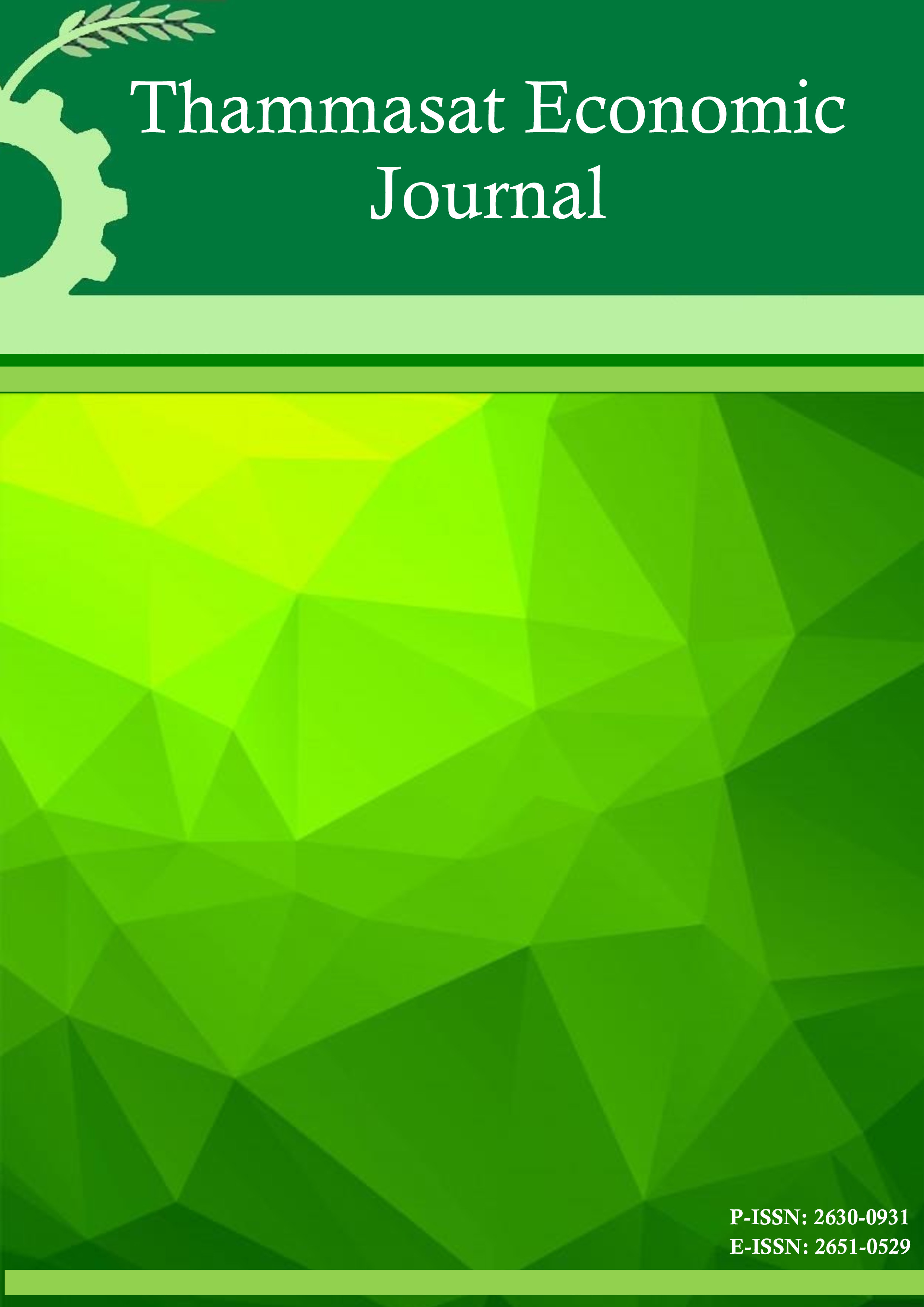การตอบสนองของเงินเฟ้อต่อตัวแปรทางเศรษฐกิจ ภายหลังการใช้กรอบเป้าเหมายเงินเฟ้อ
Keywords:
Inflation targeting, Core Inflation, Vector AutoregressiveAbstract
The purpose of this study is to investigate core inflation in Thailand after the adoption of inflation targeting policy. The main objective is to find out the response of inflation to other economic variables: interest rates of 1 day repurchase market, real minimum wage, real effective exchange rate, and manufacturing production index. The methodology is based on the assumption that there are dynamic linear relations among these economic variables. Then we use VAR model to estimate and analyze the response and proportion of shock to core inflation.
The result from impulse response function and forecast-error variance decomposition shown that the response of core inflation shock to RP1 shock is the smallest effect and the REER shock has the greatest effect on the shock of core inflation. However, the core inflation shock itself is about 89.43 percent (more than 80 percent came from the first ten months).
References
2. Sargent, T. J. (1987). Dynamic Macroeconomic Theory. Cambridge, Massachusetts & London: Harvard University.
3. Heij, C. (2004). Econometric Methods with Applications in Business and Economics. New York: Oxford university.
4. Atchana Waiquamdee. (2001). Modelling the Inflation Process in Thailand. BIS Papers, 8.
5. Aucremanne, L. & Wouters R. (1999). A Structural VAR Approach to Core Inflation and Its Relevance for Monetary Policy. Proceedings of the workshop of Central Bank Model Builders held at the BIS on 18–19, February 1999.
6. Cecchetti, S. & Debelle, G. (2005). Has the Inflation Process Changed?. CEPR, CES, MSH, Economic Policy, 26, 311-352.
7. Cecchetti S., Hooper P., Kasman B., Schoenholtz K. & Watson M. (2007). Understanding the Evolving Inflation Process. manuscript, Brandeis University, July.
8. Devereux, M. B. & Yetman J. (2002). Price Setting and Exchange Rate Pass-through: Theory and Evidence. In Price Adjustment and Monetary Policy, Proceedings of a conference held by the Bank of Canada, November 2002.
9. Gordon, D. B. & O’Regan J. (1997). Evaluating Simple Monetary-policy Rules Australia. Monetary Policy and Inflation Targeting, Proceedings of a conference held on 21-22, July 1997.
10. Ito, T., Sasaki, Y. N., & Sato K. (2005). Pass-Through of Exchange Rate Changes and Macroeconomic Shocks to Domestic Inflation in East Asian Countries. Research Institute of Economy, Trade and Industry (RIETI), Discussion papers, 05020.
11. June Charoenseang, & Pornkamol Manakit. (2006). Thai Monetary Policy Transmission in an Inflation Targeting Era. Journal of Asian Economics, 18(1), 144–157
12. Mishkin, F. S. (2000). From Monetary Targeting to Inflation Targeting: Lessons from the Industrialized Countries. Policy Research Working Paper, 2684.
13. Mishkin, F. S. & Posen, A. S. (1997). Inflation Targeting: Lessons from Four Countries. Federal Reserve Bank of New York, Economic Policy Review, 9-110.
14. O'Reilly G. & Whelan K. (2004). Has Euro-area Inflation Persistence Changed Over Time?. European Central Bank, Working Paper Series, 335.
15. Piti Disyatat, & Pinnarat Vongsinsirikul. (2002). Monetary Policy and the Transmission Mechanism in Thailand. Journal of Asian Economics, 14(3), 389-418.
16. Pichit Patrawimolpon. (2001). A Structural Vector Autoregressive Model of Thailand: A Test for Structural Shifts. Bank of Thailand, Monetary Policy Group.
17. Purvis, D. D. (1975). Inflation and the Terms of Trade. The Journal of Political Economy, 83(1), 227-230.
18. Quah, D. & Vahey, S.P. (1995). Measuring Core Inflation. The Economic Journal, 432, 1130-1144.
19. Roong Poshyananda Mallikamas, & Runchana Pongsaparn. (2005). Evolving Inflation Process: The Thai Experience. Bank of Thailand Discussion Paper.
20. Svensson, L. (1997). Inflation Forecast Targeting: Implementing and Monitoring Inflation Targets. NBER Working Papers, 5797.
21. ___________. (1999). Price-Level Targeting versus Inflation Targeting: A Free Lunch?. Journal of money, Credit, and Banking, 277-193.
22. Taylor, J. B. (1979a). Estimation and Control of Economic Model with Rational Expectation. Econometrica, 47, 1267-1286.
23. ___________. (1994). The Inflation/Output Variability Trade-off Revisited. The Federal Reserve Bank of Boston Conference Series, 38, 21-38.
24. ไพบูลย์ พงษ์ไพเชฐ. (2007). การวิเคราะห์ผลกระทบของการเปลี่ยนแปลงนโยบายการเงินโดยวิธี Factor Augmented Vector Autoregressive Approach. วิทยานิพนธ์ปริญญามหาบัณฑิต, มหาวิทยาลัยจุฬาลงกรณ์, คณะเศรษฐศาสตร์.
25. ภาคิน จิตโภคเกษม. (2007). ผลกระทบของความผันผวนของอัตราแลกเปลี่ยนต่อระดับราคาสินค้าในประเทศไทย Exchange Rate Pass-through to Consumer Price in Thailand.วิทยานิพนธ์ปริญญามหาบัณฑิต, มหาวิทยาลัยธรรมศาสตร์, คณะเศรษฐศาสตร์.
26. ธนภัทร ทรัพย์วิทยาภัณฑ์. (2005). การคาดการณ์เงินเฟ้ออย่างสมเหตุสมผล Rational Inflation Expectation. วิทยานิพนธ์ปริญญามหาบัณฑิต, มหาวิทยาลัยธรรมศาสตร์, คณะเศรษฐศาสตร์.










